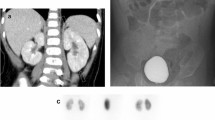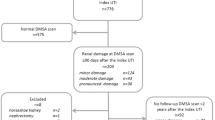Abstract.
Diagnosis of urinary infection in young children is often delayed, which may result in renal damage. However, it remains to be clarified how soon the treatment should be started to prevent renal changes. The present study prospectively enrolled young children with diagnosis of their first febrile urinary infection who underwent technetium-99m dimercaptosuccinate renal cortical scintigraphy within 120 h of initiation of treatment. Patients with abnormal renoscintigraphy received antibiotics for 2 weeks and scintigraphy was repeated 1 year later. Twenty-two children were enrolled from July 1995 through March 2000. Acute-phase renoscintigraphy identified focal defects in 0 of the 14 children who were treated within 24 h of the disease, 1 of the 3 treated in 24–48 h, and 2 of the 5 treated in 48–72 h. Repeat renoscintigraphy showed disappearance of the focal defects in all 3 children. The present study has shown that early treatment within 24 h of onset of the fever due to urinary infection should deter renal changes. Fever for more than 24 h prior to diagnosis indicates a high risk for renal changes and needs an immediate effective treatment to avoid renal damage.



Similar content being viewed by others
References
Jodal U (1987) The natural history of bacteriuria in childhood. Infect Dis Clin North Am 1:713-729
Smellie JM, Poulton A, Prescod NP (1994) Retrospective study of children with renal scarring associated with reflux and urinary infection. BMJ 308:1193-1196
Jakobsson B, Jacobson SH, Hjalmas K (1999) Vesico-ureteric reflux and other risk factors for renal damage: identification of high- and low-risk children. Acta Paediatr [Suppl] 88:31-39
Majd M, Rushton HG, Jantausch B, Wiedermann BL (1991) Relationship among vesicoureteral reflux, P-fimbriated Escherichia coli, and acute pyelonephritis in children with febrile urinary tract infection. J Pediatr 119:578-585
Melis K, Vandevivere J, Hoskens C, Vervaet A, Sand A, Van AK (1992) Involvement of the renal parenchyma in acute urinary tract infection: the contribution of 99mTc dimercaptosuccinic acid scan. Eur J Pediatr 151:536–539
Rosenberg AR, Rossleigh MA, Brydon MP, Bass SJ, Leighton DM, Farnsworth RH (1992) Evaluation of acute urinary tract infection in children by dimercaptosuccinic acid scintigraphy: a prospective study. J Urol 148:1746–1749
Jakobsson B, Nolstedt L, Svensson L, Soderlundh S, Berg U (1992) 99mTechnetium-dimercaptosuccinic acid scan in the diagnosis of acute pyelonephritis in children: relation to clinical and radiological findings. Pediatr Nephrol 6:328-334
Stokland E, Hellstrom M, Jacobsson B, Jodal U, Lundgren P, Sixt R (1996) Early 99mTc dimercaptosuccinic acid (DMSA) scintigraphy in symptomatic first-time urinary tract infection. Acta Paediatr 85:430-436
Rushton HG, Majd M, Jantausch B, Wiedermann BL, Belman AB (1992) Renal scarring following reflux and nonreflux pyelonephritis in children: evaluation with 99mtechnetium-dimercaptosuccinic acid scintigraphy. J Urol 147:1327-1332
Conway JJ, Cohn RA (1994) Evolving role of nuclear medicine for the diagnosis and management of urinary tract infection. J Pediatr 124:87–90
Hoberman A, Wald ER, Reynolds EA, Penchansky L, Charron M (1994) Pyuria and bacteriuria in urine specimens obtained by catheter from young children with fever. J Pediatr 124:513-519
Hiraoka M, Hida Y, Tuchida S, Tsukahara H, Yamashita M, Sudo, M (1993) Diagnosis of urinary tract infection by urine microscopy using a disposable counting chamber. Scand J Clin Lab Invest 53:705-709
Vickers D, Ahmad T, Coulthard MG (1991) Diagnosis of urinary tract infection in children: fresh urine microscopy or culture? Lancet 338:767-770
International Reflux Study Committee (1981) Medical versus surgical treatment of primary vesicoureteral reflux. Prospective international reflux study in children. J Urol 125:277–283
Patel K, Charron M, Hoberman A, Brown ML, Rogers KD (1993) Intra- and interobserver variability in interpretation of DMSA scans using a set of standardized criteria. Pediatr Radiol 23:506-509
Hansson S, Bollgren I, Esbjorner E, Jakobsson B, Marild S (1999) Urinary tract infections in children below two years of age: a quality assurance project in Sweden. The Swedish Pediatric Nephrology Association. Acta Paediatr 88:270-274
Hiraoka M, Hori C, Tsukahara H, Kasuga K, Ishihara Y, Sudo M (1997) Congenitally small kidneys with reflux as a common cause of nephropathy in boys. Kidney Int 52:811-816
Jakobsson B, Svensson L (1997) Transient pyelonephritic changes on 99mTechnetium-dimercaptosuccinic acid scan for at least five months after infection. Acta Paediatr 86:803-807
Risdon RA, Godley ML, Gordon I, Ransley PG (1994) Renal pathology and the 99mTc-DMSA image before and after treatment of the evolving pyelonephritic scar: an experimental study. J Urol 152:1260–1266
Rushton HG (1997) The evaluation of acute pyelonephritis and renal scarring with technetium 99m-dimercaptosuccinic acid renal scintigraphy: evolving concepts and future directions. Pediatr Nephrol 11:108–120
Author information
Authors and Affiliations
Corresponding author
Rights and permissions
About this article
Cite this article
Hiraoka, M., Hashimoto, G., Tsuchida, S. et al. Early treatment of urinary infection prevents renal damage on cortical scintigraphy. Pediatr Nephrol 18, 115–118 (2003). https://doi.org/10.1007/s00467-002-1023-y
Received:
Revised:
Accepted:
Published:
Issue Date:
DOI: https://doi.org/10.1007/s00467-002-1023-y




